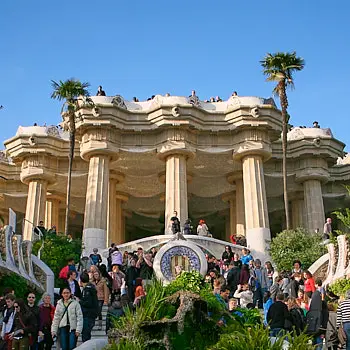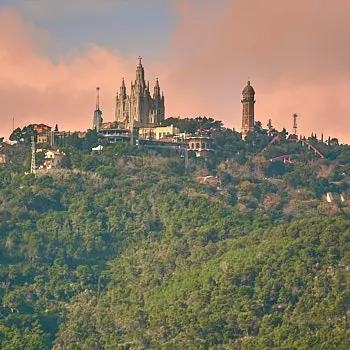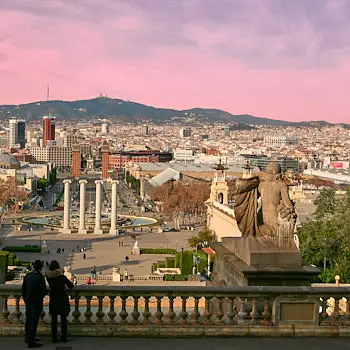Barcelona is an enchanting city that effortlessly blends a rich historical heritage with a vibrant, modern atmosphere. Its iconic architecture, most notably the awe-inspiring Sagrada Familia and the whimsical Park Güell designed by Antoni Gaudí, will leave you in awe. The city's bustling streets are filled with a contagious energy, where you can explore charming neighborhoods like the Gothic Quarter, stroll along the lively Las Ramblas, and indulge in delectable tapas at bustling local markets. Lastly, Barcelona's vibrant nightlife is legendary, with countless bars, clubs, and live music venues, ensuring you'll never run out of entertainment options. Prepare to be captivated by the city's unique blend of history, culture, and passion - Barcelona is a destination that promises an unforgettable experience.
La Sagrada Familia
La Sagrada Familia is an iconic basilica located in the heart of Barcelona, Spain. It is one of the most famous landmarks in the city and a UNESCO World Heritage Site. La Sagrada Familia is renowned for its unique architectural style, which combines elements of Gothic and Art Nouveau (Modernist) design. It was designed by the renowned Catalan architect Antoni Gaudí, who dedicated over 40 years of his life to the project.
Construction of the basilica began in 1882 and is still ongoing. Gaudí initially took over the project a year later and transformed its design significantly. However, he passed away in 1926 before its completion. Construction has continued based on his plans and designs, and it is estimated to be completed by 2026, marking the centenary of Gaudí's death.
Gaudí infused La Sagrada Familia with rich symbolism inspired by nature, religion, and Catalan culture. The basilica's facades depict various scenes from the Bible and significant religious motifs. The towering spires represent different religious figures, and the interior is filled with intricate details, including columns resembling trees and a canopy-like ceiling.
Visiting La Sagrada Familia is a truly awe-inspiring experience, and it offers the opportunity to appreciate Gaudí's architectural genius and his unique vision for the basilica.
Visit Park Güell
Park Güell is another iconic landmark in Barcelona, designed by the renowned architect Antoni Gaudí. Park Güell showcases Gaudí's distinctive architectural style, characterized by organic shapes, colorful mosaic work, and integration with nature. It is a prime example of Gaudí's use of Catalan Modernism.
The park was commissioned by Eusebi Güell, a wealthy entrepreneur and Gaudí's patron. Its construction took place between 1900 and 1914. Originally, Güell intended the park to be a residential garden city, but the project was not successful, and the park was opened to the public in 1926.
The park is divided into two areas: the Monumental Zone and the Free Access Zone. The Monumental Zone requires an entrance fee and houses some of the most impressive structures in the park. The Hypostyle Room, located at the entrance, is a large hall with 86 Doric columns. These columns support a terrace above that offers panoramic views of Barcelona. The columns also double as rainwater collectors, emphasizing Gaudí's attention to both aesthetic and functional details. Nature Square, or the Greek Theatre, is a vast open area surrounded by a long mosaic bench. The bench, covered in colorful ceramic tiles, is a popular spot for visitors to relax and enjoy the view. The square was designed to be used for public events but was never fully completed.
The Free Access Zone of the park includes the Dragon Stairway, which is flanked by a stunning mosaic dragon fountain. This area allows visitors to explore the park's natural surroundings, walking paths, and enjoy the serenity of the green spaces.

Stroll along La Rambla
La Rambla is one of Barcelona's most famous streets and a vibrant promenade that stretches for about 1.2 kilometers, connecting Plaça de Catalunya to the Columbus Monument at Port Vell.
La Rambla is known for its lively and bustling atmosphere. It is a hub of activity day and night, with locals and tourists strolling along the street, shopping, dining, and enjoying the street performers and artists.
The street is flanked by a central pedestrian boulevard with tree-lined walkways on either side. It provides pleasant shade during the hot summer months, making it an enjoyable place for a leisurely walk. As you walk along La Rambla, you'll encounter several noteworthy landmarks and sights described below.
Boqueria Market, situated just off La Rambla, known as the Mercat de Sant Josep de la Boqueria is a bustling food market where you can find an array of fresh produce, meats, seafood, and local delicacies. Plaça Reial is located towards the southern end of La Rambla. It is a picturesque square with palm trees, elegant buildings, and lively outdoor cafes. It's a great spot to relax and people-watch. At the top of La Rambla near Plaça de Catalunya, you'll find the Canaletes Fountain, a popular meeting point for locals and a symbol of Barcelona's football club, FC Barcelona.
Explore the Gothic Quarter
The Gothic Quarter (Barri Gòtic) is a historic neighborhood in the heart of Barcelona, known for its narrow medieval streets, charming squares, and Gothic architecture. The Gothic Quarter has a rich history that dates back over 2,000 years. The area was once the Roman settlement of Barcino, and remnants of its ancient walls can still be seen in some parts of the neighborhood. Walking through its streets is like stepping back in time, with buildings and structures from various historical periods. The Gothic Quarter is a maze of narrow, winding streets, some of which still retain their medieval layout. Lose yourself in the labyrinthine alleys, discover hidden squares, and stumble upon charming shops, boutiques, and cafes tucked away in unexpected corners.
The Gothic Quarter is characterized by its Gothic architecture, which includes majestic churches, narrow alleyways, and historic buildings. The most notable structures include Barcelona Cathedral (Catedral de Barcelona), a stunning cathedral, dedicated to Santa Eulalia, which is a prominent landmark of the Gothic Quarter. It features intricate facades, a beautiful cloister, and a panoramic view from its rooftop. Near the Cathedral there is Plaça del Rei. This historic square is home to the Royal Palace (Palau Reial Major), a medieval palace that was the residence of the Counts of Barcelona.
Explore Montjuïc Hill
Montjuïc Hill is a prominent hill located southwest of the city center in Barcelona. It offers a wealth of attractions, stunning views, and beautiful green spaces. Montjuïc Hill has played a significant role in Barcelona's history. It has been the site of various events, including military fortifications, the 1929 International Exposition, and the 1992 Olympic Games. Its name, Montjuïc, means "Jewish Mountain" in Catalan and refers to the Jewish cemetery that once existed here.
Montjuïc Hill provides breathtaking panoramic views of Barcelona and its surroundings. From its elevated vantage point, you can enjoy sweeping vistas of the city, the Mediterranean Sea, and the nearby port area.
Atop the hill stands Montjuïc Castle (Castell de Montjuïc), a fortress originally built in the 17th century and later reconstructed. It offers a glimpse into Barcelona's military history and provides commanding views of the city. Today, it houses a military museum and is a popular attraction for visitors.

Visit Casa Batlló and Casa Milà
Casa Batlló and Casa Milà, also known as La Pedrera, are two of the most iconic buildings in Barcelona, both designed by the renowned architect Antoni Gaudí.
Casa Batlló is a prime example of Gaudí's distinctive architectural style. It is characterized by its imaginative design, undulating facade, and intricate details. The exterior of Casa Batlló is adorned with colorful ceramic tiles, organic shapes, and skeletal balconies resembling masks. The facade represents the legend of Saint George slaying a dragon, with the dragon's back symbolized by the tiled roof. The interior of Casa Batlló is equally remarkable, featuring curved walls, mosaic-covered ceilings, and skylights that allow natural light to flood the spaces. Gaudí paid attention to every detail, from the door handles and windows to the furniture and decorative elements.
Casa Milà is another masterpiece of Gaudí's Modernist architecture. Its name, La Pedrera, translates to "The Quarry" due to its rough-hewn stone facade. The exterior of Casa Milà is characterized by its undulating walls, wrought-iron balconies, and sculptural elements. The facade lacks straight lines, giving the building an organic and flowing appearance. The rooftop of Casa Milà is one of its most distinctive features. It is adorned with chimney stacks that resemble medieval knights and offers panoramic views of Barcelona. The rooftop also houses a unique terrace with arched structures and mosaic benches.
Both Casa Batlló and Casa Milà are UNESCO World Heritage Sites and offer visitors the opportunity to appreciate Gaudí's unique vision and his innovative approach to architecture. Exploring these buildings provides a fascinating glimpse into the creativity and genius of one of the world's most celebrated architects.
Explore Park de la Ciutadella
Parc de la Ciutadella is a large public park located in the heart of Barcelona. It offers a tranquil escape from the bustling city and provides a variety of attractions and activities. Parc de la Ciutadella has a rich historical background. It was originally created in the mid-19th century on the grounds of the former military citadel (ciutadella) that was demolished. The park was designed by the architect Josep Fontsére, with contributions from Antoni Gaudí and others.
The park's landscaping features a mix of lush green spaces, ornamental gardens, and tree-lined pathways. Its design is influenced by the principles of Romanticism and includes elements such as ponds, fountains, and statues. One of the park's most significant landmarks is the Cascada Monumental, a grand waterfall and fountain complex designed by Josep Fontsére. It was inspired by the Trevi Fountain in Rome and incorporates sculptural elements, including a chariot driven by horses.
Parc de la Ciutadella includes a large lake known as the Lake of the Ciutadella (Llac de la Ciutadella). Visitors can rent rowboats or paddleboats and enjoy a relaxing ride on the tranquil waters of the lake, offering a unique perspective of the park. Parc de la Ciutadella offers ample space for recreation and leisure activities. You can find areas for picnicking, sunbathing, playing sports, and enjoying a leisurely stroll or bike ride.
Visit the Magic Fountain of Montjuïc
The Fountain of Montjuïc, also known as the Magic Fountain (Font Màgica), is a spectacular fountain located at the foot of Montjuïc Hill in Barcelona. The Magic Fountain was built for the 1929 Barcelona International Exposition and designed by Carles Buïgas. It was initially constructed as a temporary installation but was later rebuilt and became a permanent fixture due to its popularity.
The highlight of the Magic Fountain is its mesmerizing water and light show, which takes place in the evenings. The fountain features a series of cascading water jets and is accompanied by a synchronized display of colorful lights and music. The fountain's water and light show is choreographed to a selection of music, ranging from classical to contemporary, creating a captivating and immersive experience. The water jets are precisely timed to the music, dancing and changing patterns in synchronization.
The Magic Fountain is one of Barcelona's most popular tourist attractions, drawing large crowds of visitors. It offers a free and accessible spectacle that can be enjoyed by people of all ages. The fountain operates on a seasonal schedule, with varying show times throughout the year. It is best to check the official website or local information for the current show schedule to plan your visit accordingly.

